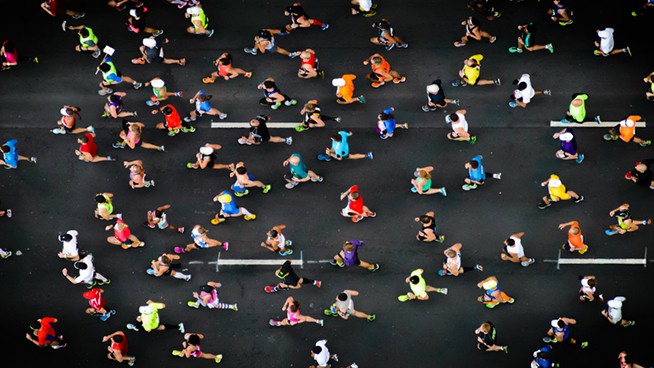Tune Up Your 40-Yard Dash
Running a scorching 40 requires more than pure speed. Several other factors contribute to running a fast time: stride length, stride frequency and explosiveness.
Stride Length
The more distance you can cover and the faster you can take another step, the better your time will be. Fundamental components of improving stride length are increasing hip mobility for full range of motion and developing a powerful knee drive.
Drills like Bounding do both. The exercise strengthens your stride because it fires up the central nervous system for more power into the ground and opens up the hips for full stride range of motion.
Bounding
Who’s doing it?
Atlanta Falcons DB Dunta Robinson
Recommended by: Corey Stenstrup, IMG Academies performance specialist
- Jump from one leg to the other in running fashion
- Fully extend back leg while raising front leg into high knee position
- Explode quickly and cover as much ground as possible with each bound
- Repeat for specified distance
Reps/Distance: 2×25 yards
Stride Frequency
Stride frequency refers to how quickly you can cycle your legs when sprinting. By improving frequency, you decrease the time between steps and become faster if stride length is unchanged.
The key to increasing stride frequency is to strike the ground with the ball of your foot under the hip, with your toes up. This allows you to explosively apply force and reduces the time your foot is in contact with the ground, resulting in greater speed.
To improve stride frequency, Overspeed Sprints are beneficial because they force your legs to move faster.
Overspeed Sprints
Who’s doing it?
Green Bay Packers LB A.J. Hawk
Recommended by: Mike Durant, D1 Training facility coordinator
- Attach overspeed cord to body harness
- Begin in starting stance with partner in front so cord has tension
- Sprint 30 yards while partner runs in front at constant rate entire length
Sets/Reps: 4-5x 30 yards
Explosiveness
An explosive drive phase produces a faster start and improves acceleration. To effectively work the drive phase, perform exercises that add resistance to the hips and hamstrings, such as Sled Pulls. As you sprint against the resistance, you train your central nervous system to tell your body to work harder. Once the resistance is removed, your muscles work just as hard, producing an immediate surge in running speed.
Sled Pulls
Who’s doing it?
New Orleans Saints WR Marques Colston
Recommended by: Lynn Goff, Professional Athletic Performance Center athletic trainer
- Attach weighted sled to body harness; add 10 to 15 percent of your bodyweight to sled
- Sprint 30 yards pulling sled
Reps/Distance: 5×30 yards
Coaching Points: Drive knees up // Maintain forward 45-degree angle // Drive arms forward and back // Work for full hip extension
Related link:
Cues to help refine your 40-Yard Dash start technique.
RECOMMENDED FOR YOU
MOST POPULAR
Tune Up Your 40-Yard Dash
Running a scorching 40 requires more than pure speed. Several other factors contribute to running a fast time: stride length, stride frequency and explosiveness.
Stride Length
The more distance you can cover and the faster you can take another step, the better your time will be. Fundamental components of improving stride length are increasing hip mobility for full range of motion and developing a powerful knee drive.
Drills like Bounding do both. The exercise strengthens your stride because it fires up the central nervous system for more power into the ground and opens up the hips for full stride range of motion.
Bounding
Who’s doing it?
Atlanta Falcons DB Dunta Robinson
Recommended by: Corey Stenstrup, IMG Academies performance specialist
- Jump from one leg to the other in running fashion
- Fully extend back leg while raising front leg into high knee position
- Explode quickly and cover as much ground as possible with each bound
- Repeat for specified distance
Reps/Distance: 2×25 yards
Stride Frequency
Stride frequency refers to how quickly you can cycle your legs when sprinting. By improving frequency, you decrease the time between steps and become faster if stride length is unchanged.
The key to increasing stride frequency is to strike the ground with the ball of your foot under the hip, with your toes up. This allows you to explosively apply force and reduces the time your foot is in contact with the ground, resulting in greater speed.
To improve stride frequency, Overspeed Sprints are beneficial because they force your legs to move faster.
Overspeed Sprints
Who’s doing it?
Green Bay Packers LB A.J. Hawk
Recommended by: Mike Durant, D1 Training facility coordinator
- Attach overspeed cord to body harness
- Begin in starting stance with partner in front so cord has tension
- Sprint 30 yards while partner runs in front at constant rate entire length
Sets/Reps: 4-5x 30 yards
Explosiveness
An explosive drive phase produces a faster start and improves acceleration. To effectively work the drive phase, perform exercises that add resistance to the hips and hamstrings, such as Sled Pulls. As you sprint against the resistance, you train your central nervous system to tell your body to work harder. Once the resistance is removed, your muscles work just as hard, producing an immediate surge in running speed.
Sled Pulls
Who’s doing it?
New Orleans Saints WR Marques Colston
Recommended by: Lynn Goff, Professional Athletic Performance Center athletic trainer
- Attach weighted sled to body harness; add 10 to 15 percent of your bodyweight to sled
- Sprint 30 yards pulling sled
Reps/Distance: 5×30 yards
Coaching Points: Drive knees up // Maintain forward 45-degree angle // Drive arms forward and back // Work for full hip extension
Related link:
Cues to help refine your 40-Yard Dash start technique.












